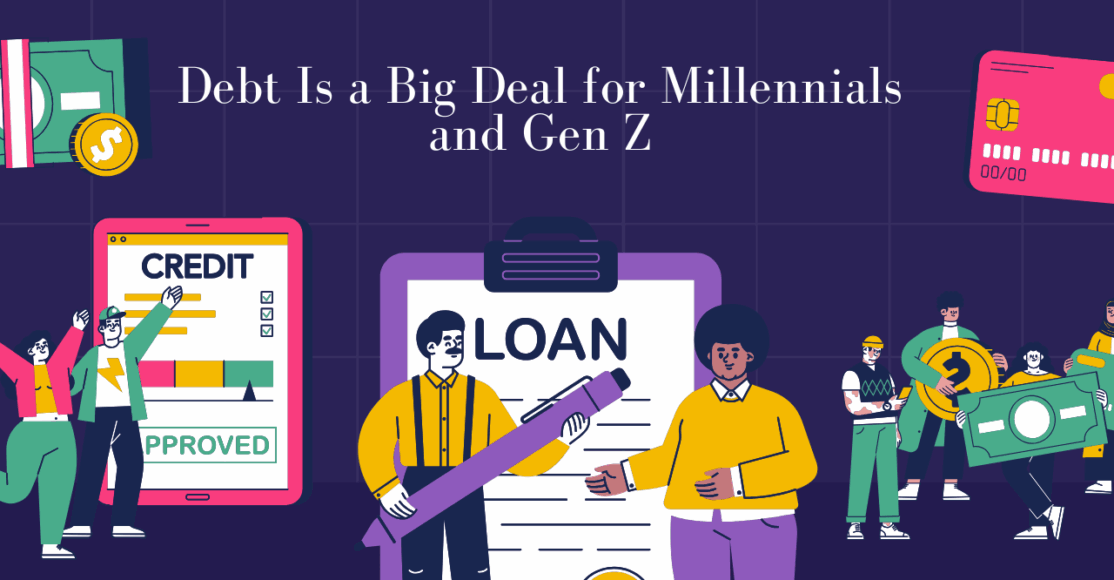
- May 2, 2025
- admin
- 0 Comments
- Uncategorized
Debt Management for Millennials and Gen Z: Tips for 2025’s Young Borrowers in India
Namaste, Millennials and Gen Z! If you’re in your 20s or 30s in India, you’re probably busy
with a lot—starting your first job, paying rent in cities like Mumbai or Bengaluru, or dreaming
big about buying a bike, a house, or traveling to places like Goa or the Himalayas. But let’s
talk about something that might be worrying you: debt. Whether it’s an education loan, credit
card bills, or a bike loan, debt can feel like a heavy school bag on your shoulders. The good
news? You can manage it—and even clear it faster—with some easy steps. In this blog, I’ll
share simple debt management tips for 2025 that fit your life as a young Indian borrower. If
you’ve been searching for debt management for Millennials and Gen Z, this blog is just for
you. Let’s get started!
Why Debt Is a Big Deal for Millennials and Gen Z in India in 2025
First, let’s understand why debt is such a common challenge for young Indians like you.
Millennials (born 1981–1996) and Gen Z (born 1997–2012) face some unique money
problems:
Education Loans: Many of you took loans to study at colleges like IITs, IIMs, or private
universities. In India, an education loan in India 2025 can easily be ₹5–10 lakh, and it can
take years to pay off.
Credit Card Debt: With online shopping on apps like Amazon and Flipkart, subscription
services like Netflix, and the temptation of “buy now, pay later” options, it’s easy to pile up
credit card debt repayment India without noticing.
Rising Costs: Rent in cities like Delhi or Pune, groceries, and daily expenses like chai and
metro fares keep going up, leaving less money to pay off debt.
Economic Challenges: In 2025, India is dealing with things like inflation (prices of things
like veggies and petrol are rising), higher interest rates, and global money pressures. This
makes borrowing more expensive and paying off debt tougher.
But here’s the good news: you’re tech-savvy, you care about learning how to handle money,
and you’re eager to grow. Plus, as India’s economy grows, you’re set to earn more and
maybe even inherit family wealth in the future. If you manage your debt wisely now, you can
build a bright financial future!
Step 1: Understand Your Debt
The first step to managing debt is knowing exactly what you owe. It might sound boring, but
trust me—it feels great to have a clear picture.
List Your Debts: Write down every debt you have. For example:
● Education loan: ₹5,00,000 at 8% interest
● Credit card: ₹50,000 at 36% interest (credit cards in India often have high rates!)
● Bike loan: ₹1,00,000 at 10% interest
Check the Details: For each debt, note the interest rate (the extra cost of borrowing) and the
minimum monthly payment. The interest rate is important because high rates (like on credit
cards) make debt grow faster.
Know Your Total: Add up all your debts to see the full picture. In the example above, that’s
₹6,50,000.
Why This Helps: When you know what you owe, you can make a plan to tackle it. It’s like
knowing how far you need to travel—it makes the journey less scary.
Step 2: Create a Budget That Works for You
A budget is like a map for your money—it shows you where your money goes and helps you
find extra cash to pay off debt. As a young Indian, you probably already use apps like Paytm
or Google Pay, so this should feel easy. For better control, consider using the best
budgeting apps for young Indians like ET Money, Moneycontrol, or Walnut to track your
monthly expenses.
Use the 50/30/20 Rule:
50% Needs: Spend on must-haves like rent, groceries, and transport (like your metro pass
or petrol).
30% Wants: Spend on fun stuff like Zomato orders, movies, or shopping.
20% Savings/Debt: Use this to pay off debt or save for the future.
Example: If you earn ₹40,000 a month (a common starting salary in cities):
₹20,000 for needs (rent, food, etc.)
₹12,000 for wants (entertainment, shopping)
₹8,000 for debt payments
Tip for 2025: To pay off debt faster, cut back on your “wants.” Maybe skip that extra OTT
subscription or make chai at home instead of buying it for ₹20 every day. Even saving
₹1,000 a month can help when you put it toward your debt.
Step 3: Pick a Debt Payoff Strategy
There are two easy ways to pay off debt, and both work well for young borrowers in India.
Pick the one that suits you:
Debt Snowball Method: Start with your smallest debt first. Pay it off quickly to feel
motivated, then move to the next smallest debt.
Debt Avalanche Method: Focus on the debt with the highest interest rate first. This saves
you money on interest over time.
Why This Works: Both methods help you focus on one debt at a time while paying the
minimum on your other debts. The snowball method gives you quick wins to keep you going,
while the avalanche method saves you more money in the long run. These are great
approaches to long-term debt management for Millennials and Gen Z
Step 4: Use Tech to Your Advantage
Millennials and Gen Z in India are super tech-savvy, so let’s use that to manage debt smarter
in 2025. Here are some ideas:
● Budgeting Apps: Apps like Walnut, Moneycontrol, or ET Money can track your
spending and help you stick to your budget.
● Debt Payoff Tools: Use online calculators (available on banking websites like SBI or
HDFC) to plan how to pay off your debt.
● Digital Payments: In 2025, digital payments are everywhere in India—think UPI
apps like PhonePe and Google Pay. Use them to your advantage by setting up UPI
payments for EMI so you never miss a due date.
Also, rely on digital tools for debt tracking—they help monitor balances, send reminders,
and reduce stress.
Caution: Be careful with “buy now, pay later” options on apps like Flipkart or Amazon.
They’re tempting—like buying a ₹10,000 phone and paying later—but they can add to your
debt if you’re not careful.
Step 5: Find Ways to Earn Extra Money
One of the best ways to pay off debt faster is to earn more money. As a young Indian, you’ve
got energy and skills—let’s use them!
Try side hustles for Gen Z in India like:
● Freelancing: writing, design, social media
● Delivery or Rideshare: Zomato, Swiggy, Rapido
● Selling Stuff: OLX or Quikr
● Monetize Hobbies: Reels, art, food
● Ask for a Raise: If your performance is strong, negotiate for more pay
Example: Let’s say you earn ₹5,000 a month from a side hustle. If you put that toward your
₹50,000 credit card debt, you could pay it off in just 10 months instead of years.
Step 6: Cut Back on Spending (Without Feeling Deprived)
You don’t have to give up everything you love to pay off debt, but small changes can free up
money. Here’s how to save without feeling like you’re missing out:
● Cancel excess subscriptions
● Cook more meals at home
● Shop during sales or use cashback apps
These changes fall under smart personal finance tips India and can really accelerate your
progress.
Step 7: Build an Emergency Fund (Even a Small One)
This might sound strange when you’re focused on paying off debt, but having a small
emergency fund India 2025 can stop you from adding more debt.
Start Small: Aim for ₹10,000 to ₹20,000 in a savings account.
How to Save: Put ₹1,000 a month into your emergency fund until you reach your goal.
Why This Helps: An emergency fund gives you a safety net, so you can focus on paying off
debt without worrying about sudden expenses.
Step 8: Stay Motivated and Celebrate Wins
Track Your Progress: Use a notebook or app to see how much debt you’ve paid off. Celebrate Small Wins: Paid off your credit card? Treat yourself to something small. Connect with Others: Share your journey and motivate each other
Step 9: Think About Your Future (Sustainable Choices)
Millennials and Gen Z in India care a lot about sustainability—not just for the planet, but for your wallet too. In 2025, there’s a big push toward sustainable finance India, like supporting solar energy and reducing pollution.
● Save on bills with energy-efficient products
● Explore green incentives like solar panel subsidies
● Look into ESG funds for smart investing Why This Matters: Making smart, sustainable choices now can save you money in the long run, helping you stay debt-free and build savings.
Step 10: Get Help If You Need It
If your debt feels too much, you don’t have to handle it alone. ● Credit counseling services India like Disha Trust can guide you ● Consider debt consolidation if you have many loans ● Talk to trusted family or friends Caution: Avoid scams. Stick to verified credit counseling services India or financial advisors.
Final Thoughts
Debt management doesn’t have to be stressful, even in 2025 with all the economic challenges in India. As a Millennial or Gen Z, you’ve got the tools, energy, and mindset to take control of your money. Start by understanding your debt, making a budget, and picking a payoff strategy that works for you. Use tech to stay on track, earn extra money with side hustles, and cut back on spending without giving up the things you love. Build a small emergency fund, stay motivated, and think about sustainable choices for your future. You’re already doing great by wanting to tackle your debt—that’s a big step! Keep going, celebrate your progress, and imagine the freedom you’ll feel when you’re debt-free.


Leave a Comment